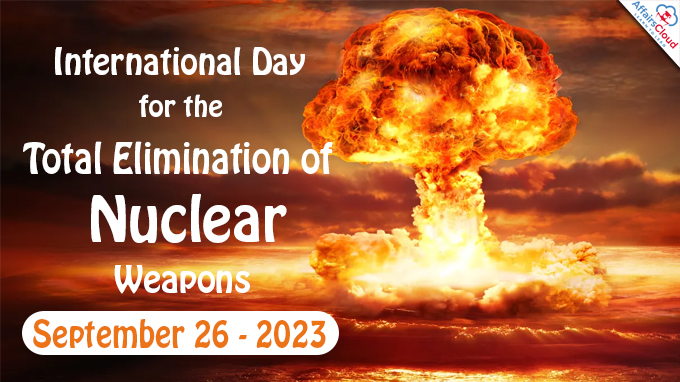 The United Nations (UN) International Day for the Total Elimination of Nuclear Weapons is annually observed across the globe on 26 September to enhance public awareness about the threat posed to humanity by nuclear weapons and the necessity for their total elimination.
The United Nations (UN) International Day for the Total Elimination of Nuclear Weapons is annually observed across the globe on 26 September to enhance public awareness about the threat posed to humanity by nuclear weapons and the necessity for their total elimination.
- This day provides an opportunity to educate the public about the real benefits of eliminating such weapons, and the social and economic costs of perpetuating them.
Background:
i.On 26 September 2013, the United Nations General Assembly (UNGA) adopted a resolution A/RES/68/32 and declared 26 September of every year as the International Day for the Total Elimination of Nuclear Weapons.
- The resolution was the follow-up to the UNGA’s first-ever high-level meeting on nuclear disarmament in 2013.
ii.The first-ever International Day for the Total Elimination of Nuclear Weapons was observed on 26 September 2014.
UN Platform for Nuclear-Weapon-Free Zones:
i.Nuclear-Weapon-Free Zones (NWFZs) are regional agreements aimed at strengthening global nuclear non-proliferation and disarmament efforts while promoting peace and security.
ii.The UNGA resolution 3472 (XXX) B (1975) defines NWFZs as zones recognized by the UNGA and established by a group of States through a treaty or convention whereby:
- The statute of total absence of nuclear weapons to which the zone shall be subject, including the procedure for the delimitation of the zone, is defined;
- An international system of verification and control is established to guarantee compliance with the obligations deriving from that statute.
Some Treaties involved in NWFZs:
Treaty of Tlatelolco:
The Treaty established the Prohibition of Nuclear Weapons in Latin America and the Caribbean became the 1st NWFZ in a highly populated area, which was opened for signature on 14 February 1967 in Mexico City.
Treaty of Rarotonga:
The South Pacific became the 2nd NWFZ in 1985 and entered into force on 11 December 1986.
Treaty of Bangkok:
Southeast Asia became the 3rd NWFZ was signed on 15 December 1995 by 10 Southeast Asian States. It entered into force on 27 March 1997.
- It is also called the Southeast Asia Nuclear Weapon-Free Zone, also known as the SEANWFZ Treaty.
Treaty of Pelindaba:
Africa became the 4th NWFZ. It is also known as the African NWFZ Treaty, opened for signature on 12 April 1996 in Cairo, Egypt, and entered into force on 15 July 2009.
Treaty on a NWFZ in Central Asia: Central Asia became the 5th NWFZ in 2006.
Note: Currently, 5 NWFZs, covering territories in most of the Southern Hemisphere and in Central Asia. Antarctica and Mongolia have a special nuclear-weapon-free status.
Strategic Arms Reduction Treaty:
i.Strategic Arms Reduction Treaty (START I) was signed in 1991 and was a bilateral arms control treaty between the USA and the Soviet Union (Russia). It entered into force in 1994, after the Soviet Union’s dissolution, and eventually expired in 2009.
ii.On 3 February 2021, the United States and Russian Federation agreed to extend the Treaty on Measures for the Further Reduction and Limitation of Strategic Offensive Arms (“new START”) until 4 February 2026.
iii.On 21 February 2023, the Russian Federation announced the suspension of its participation in the New START Treaty.
- The suspension threatens future arms control measures between the two largest nuclear powers. The breakdown of these treaties threatens global security and stability.




